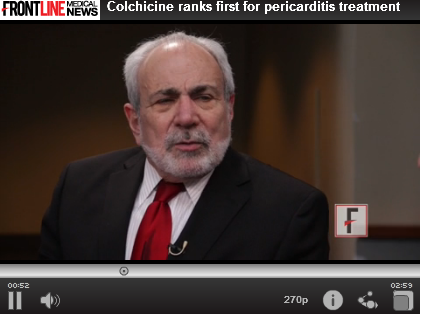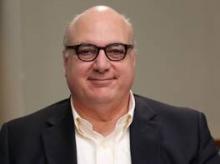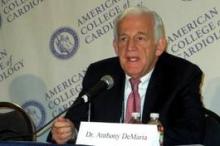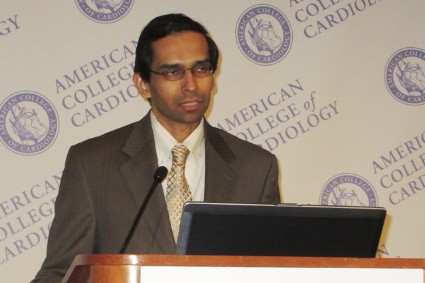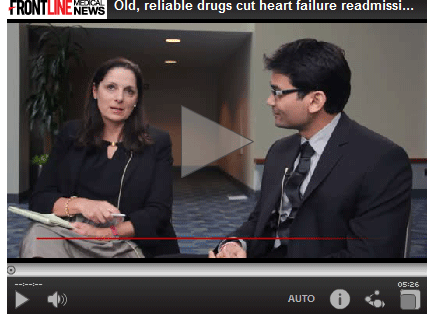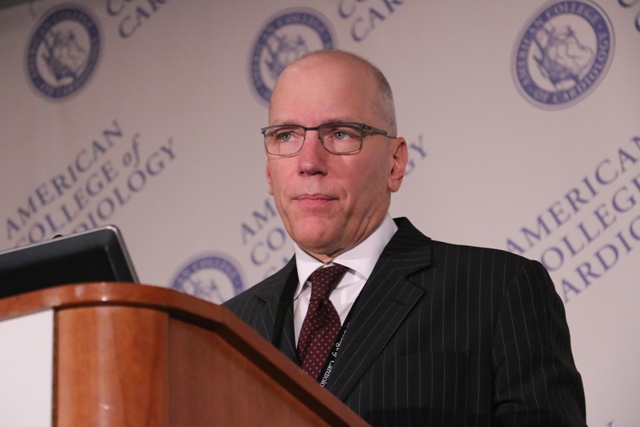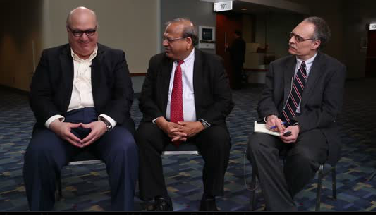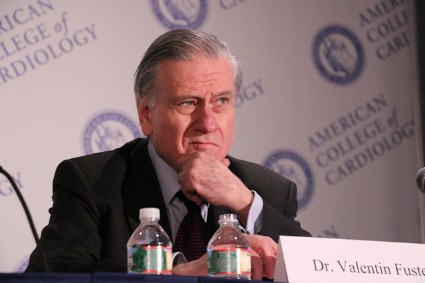User login
VIDEO: Study of hs-cTnT in chest pain intriguing, but flawed
WASHINGTON – The lack of detectable high-sensitivity cardiac troponin T in patients presenting with chest pain may be a marker of minimal risk of myocardial infarction within 30 days, according to Dr. Nadia Bandstein of the department of medicine at the Karolinska Institute, Solna, Sweden.
She and her colleagues looked at data from all emergency department visits for chest pain during 2010-2012 in Sweden. They found that the negative predictive value of myocardial infarction at 30 days for patients reporting with an hs-cTnT level of less than 5 ng/L, in addition to an ECG showing no blood flow-related damage, was 99.8%. That negative predictive value for death, meaning the patients are not at risk, was 100%.
Discussant Dr. Allan Jaffe of the Mayo Clinic in Rochester, Minn., said in an interview that although these findings are promising, the documentation in this study is not sufficient to use in clinical practice to let patients with these characteristics leave the emergency department.
*Update (3/31/14): This video has been updated.
The video associated with this article is no longer available on this site. Please view all of our videos on the MDedge YouTube channel
emergency department, Dr. Allan Jaffe, ACC
WASHINGTON – The lack of detectable high-sensitivity cardiac troponin T in patients presenting with chest pain may be a marker of minimal risk of myocardial infarction within 30 days, according to Dr. Nadia Bandstein of the department of medicine at the Karolinska Institute, Solna, Sweden.
She and her colleagues looked at data from all emergency department visits for chest pain during 2010-2012 in Sweden. They found that the negative predictive value of myocardial infarction at 30 days for patients reporting with an hs-cTnT level of less than 5 ng/L, in addition to an ECG showing no blood flow-related damage, was 99.8%. That negative predictive value for death, meaning the patients are not at risk, was 100%.
Discussant Dr. Allan Jaffe of the Mayo Clinic in Rochester, Minn., said in an interview that although these findings are promising, the documentation in this study is not sufficient to use in clinical practice to let patients with these characteristics leave the emergency department.
*Update (3/31/14): This video has been updated.
The video associated with this article is no longer available on this site. Please view all of our videos on the MDedge YouTube channel
WASHINGTON – The lack of detectable high-sensitivity cardiac troponin T in patients presenting with chest pain may be a marker of minimal risk of myocardial infarction within 30 days, according to Dr. Nadia Bandstein of the department of medicine at the Karolinska Institute, Solna, Sweden.
She and her colleagues looked at data from all emergency department visits for chest pain during 2010-2012 in Sweden. They found that the negative predictive value of myocardial infarction at 30 days for patients reporting with an hs-cTnT level of less than 5 ng/L, in addition to an ECG showing no blood flow-related damage, was 99.8%. That negative predictive value for death, meaning the patients are not at risk, was 100%.
Discussant Dr. Allan Jaffe of the Mayo Clinic in Rochester, Minn., said in an interview that although these findings are promising, the documentation in this study is not sufficient to use in clinical practice to let patients with these characteristics leave the emergency department.
*Update (3/31/14): This video has been updated.
The video associated with this article is no longer available on this site. Please view all of our videos on the MDedge YouTube channel
emergency department, Dr. Allan Jaffe, ACC
emergency department, Dr. Allan Jaffe, ACC
AT ACC 14
Ineffective renal denervation blamed for trial’s failure
WASHINGTON – Renal denervation’s not so simple after all.
Highly anticipated data from the large, sham-controlled renal-artery catheter denervation trial, SYMPLICITY HTN-3, gave its investigators reason to believe that inconsistent and inadequate delivery of nerve-ablating radiofrequency energy by inexperienced operators left too many patients undertreated, producing a neutral outcome for the primary endpoint, the study’s top-line result first reported in a company press release in January.
In the SYMPLICITY HTN-3 (Renal Denervation in Patients With Uncontrolled Hypertension) trial, the average systolic blood pressure reduction among the 364 patients randomized to renal denervation was 14 mm Hg, compared with an average 12 mm Hg reduction in 174 control patients who underwent a renal-artery angiogram masked to resemble a denervation procedure, a difference that was not statistically significant, falling substantially short of the prespecified 5 mm Hg between group difference necessary to fulfill superiority, Dr. Deepak L. Bhatt said at the annual meeting of the American College of Cardiology.
Although several factors likely led to the neutral outcome, including an unexpectedly robust blood pressure drop in the control arm, another major factor, many suspect, was inadequate delivery of the denervation treatment.
"It might be that the way we used the catheter wasn’t ideal," said Dr. Bhatt, coprincipal investigator of the study, professor of medicine at Harvard Medical School and executive director of interventional cardiology at Brigham and Women’s Hospital, both in Boston.
Concurrent with Dr. Bhatt’s report at the meeting a published version appeared online (N. Engl. J. Med. 2014 March 29 [doi:10.1056/NEJMoa1402670]).
"There is the concept that renal denervation is easy. As a catheter procedure it is easy, but to achieve denervation is far from easy," said Dr. Murray D. Esler, a professor of medicine at Monash University and senior director of the Baker IDI Heart and Diabetes Institute, both in Melbourne, and a pioneer of renal denervation who was involved in prior SYMPLICITY studies of the same renal-denervation device but was not a coinvestigator for the new trial.
"The SYMPLICITY 3 study made a mistake thinking it could get away with not giving the proceduralists any hands-on experience" before the trial. "There was none. The operators hadn’t done it before, and the trial’s designers would not have done that unless they thought that denervation was easy. Well, it’s not easy. There is a learning curve, and I think that’s the main explanation of what went wrong. "
Exacerbating the operators’ inexperience with denervation (they were all experienced interventional cardiologists) was a second flaw in the trial’s design: No method was used to monitor the efficacy of each denervation procedure, an easy decision because there is still no proven way to measure denervation efficacy during the procedure. Dr. Esler said he believes that he has a solution, one that involves testing for interrupted activity of the parallel, afferent nerves of the renal arteries using adenosine as a surrogate measure for denervation of the target efferent nerves. But while he is optimistic the adenosine approach will work, it is still at least several months from use in a trial.
In the first clinical study of renal denervation, a series of 50 patients treated at five centers in Australia and Europe reported just 5 years ago (Lancet 2009;373:1275-81), Dr. Esler, a lead investigator for that study, and his associates carefully tested the efficacy of denervation in 10 patients by measuring the direct effect of successful denervation, reduction of renal norepinephrine spillover. They reported that, in those 10 patients, renal denervation cut norepinephrine spillover by an average 47%, which correlated with an average reduction in systolic blood pressure of 22 mm Hg after 6 months.
But this effect from denervation was "far from uniform and ranged from zero to 85%," depending on who was doing the denervation. "It’s obviously operator dependent." Dr. Esler said in an interview. This observation of enormous variability in the physiologic impact of denervation "took on a new context with the failed trial. The denervation done by novices explains to some extent the spread [in results] and makes me think the same thing happened in SYMPLICITY 3."
"If you don’t do enough high-frequency burns or if the catheter doesn’t reach enough nerves" because of misplacement within the renal artery, the denervation won’t be very successful, noted Dr. George Bakris, professor of medicine and director of the comprehensive hypertension center at the University of Chicago and coprincipal investigator of SYMPLICITY HTN-3 along with Dr. Bhatt. "It certainly calls into question whether they denervated effectively. One could argue that if denervation were done appropriately" it would add to drug treatment, Dr. Bakris said in an interview. "This issue has come up about the quality of the denervation; the good news is that it can be done correctly," but that will require "a good understanding of what you are doing to the renal nerves and how much energy you need." SYMPLICITY HTN-3 "was a good but expensive learning experience," Dr. Bakris said.
The investigators "were performing a procedure, but they didn’t have the evidence that the procedure was accomplishing what it meant to accomplish," commented Dr. Anthony DeMaria, professor of medicine, the Judith and Jack White chair of cardiology, and director of the cardiovascular center at the University of California, San Diego, who was not involved in the trial. "Most of us feel there are tantalizing data to suggest that denervation can have a benefit, but they need to go back to the physiology to be sure they are denervating effectively."
Though Dr. Bakris and Dr. Esler cautioned that the study’s primary outcome was neutral, they see reason to hope that renal denervation will still prove to have an important and useful clinical effect.
"This report is the tip of the iceberg," Dr. Bakris noted. "When you look at the effect of denervation on blood pressure variability, heart rate variability, and total control over 24 hours using ambulatory blood pressure monitoring, you see a different picture," results that will be reported later this year, he said.
And Dr. Esler said that his experience using renal denervation on about 300 patients with treatment-resistant hypertension has convinced him that denervation can produce real benefits when done properly.
"I’m not changing my practice" using renal denervation on refractory patients, he said. "I accumulated a lot of patients with severe, resistant hypertension, patients whom I couldn’t control with seven or eight different drug classes. But when renal denervation came along, it was like chalk and cheese. Suddenly, I had a therapy that worked. My clinical experience in patients who didn’t budge with medications totally convinces me" that renal denervation works.
SYMPLICITY HTN-3 was sponsored by Medtronic, the company that markets the device tested in the study. Dr. Bhatt said that he has received research grants from Medtronic and five other companies. Dr. Esler said that he has received consulting fees, honoraria, and research grants from Medtronic. Dr. Bakris said that he has received personal fees from Medtronic and five other companies. Dr. DeMaria said that he has received research grants from Angioblast Systems, Cardiovascular Biotherapeutics, General Electric Medical, Gilead, and Lantheus.
On Twitter @mitchelzoler
WASHINGTON – Renal denervation’s not so simple after all.
Highly anticipated data from the large, sham-controlled renal-artery catheter denervation trial, SYMPLICITY HTN-3, gave its investigators reason to believe that inconsistent and inadequate delivery of nerve-ablating radiofrequency energy by inexperienced operators left too many patients undertreated, producing a neutral outcome for the primary endpoint, the study’s top-line result first reported in a company press release in January.
In the SYMPLICITY HTN-3 (Renal Denervation in Patients With Uncontrolled Hypertension) trial, the average systolic blood pressure reduction among the 364 patients randomized to renal denervation was 14 mm Hg, compared with an average 12 mm Hg reduction in 174 control patients who underwent a renal-artery angiogram masked to resemble a denervation procedure, a difference that was not statistically significant, falling substantially short of the prespecified 5 mm Hg between group difference necessary to fulfill superiority, Dr. Deepak L. Bhatt said at the annual meeting of the American College of Cardiology.
Although several factors likely led to the neutral outcome, including an unexpectedly robust blood pressure drop in the control arm, another major factor, many suspect, was inadequate delivery of the denervation treatment.
"It might be that the way we used the catheter wasn’t ideal," said Dr. Bhatt, coprincipal investigator of the study, professor of medicine at Harvard Medical School and executive director of interventional cardiology at Brigham and Women’s Hospital, both in Boston.
Concurrent with Dr. Bhatt’s report at the meeting a published version appeared online (N. Engl. J. Med. 2014 March 29 [doi:10.1056/NEJMoa1402670]).
"There is the concept that renal denervation is easy. As a catheter procedure it is easy, but to achieve denervation is far from easy," said Dr. Murray D. Esler, a professor of medicine at Monash University and senior director of the Baker IDI Heart and Diabetes Institute, both in Melbourne, and a pioneer of renal denervation who was involved in prior SYMPLICITY studies of the same renal-denervation device but was not a coinvestigator for the new trial.
"The SYMPLICITY 3 study made a mistake thinking it could get away with not giving the proceduralists any hands-on experience" before the trial. "There was none. The operators hadn’t done it before, and the trial’s designers would not have done that unless they thought that denervation was easy. Well, it’s not easy. There is a learning curve, and I think that’s the main explanation of what went wrong. "
Exacerbating the operators’ inexperience with denervation (they were all experienced interventional cardiologists) was a second flaw in the trial’s design: No method was used to monitor the efficacy of each denervation procedure, an easy decision because there is still no proven way to measure denervation efficacy during the procedure. Dr. Esler said he believes that he has a solution, one that involves testing for interrupted activity of the parallel, afferent nerves of the renal arteries using adenosine as a surrogate measure for denervation of the target efferent nerves. But while he is optimistic the adenosine approach will work, it is still at least several months from use in a trial.
In the first clinical study of renal denervation, a series of 50 patients treated at five centers in Australia and Europe reported just 5 years ago (Lancet 2009;373:1275-81), Dr. Esler, a lead investigator for that study, and his associates carefully tested the efficacy of denervation in 10 patients by measuring the direct effect of successful denervation, reduction of renal norepinephrine spillover. They reported that, in those 10 patients, renal denervation cut norepinephrine spillover by an average 47%, which correlated with an average reduction in systolic blood pressure of 22 mm Hg after 6 months.
But this effect from denervation was "far from uniform and ranged from zero to 85%," depending on who was doing the denervation. "It’s obviously operator dependent." Dr. Esler said in an interview. This observation of enormous variability in the physiologic impact of denervation "took on a new context with the failed trial. The denervation done by novices explains to some extent the spread [in results] and makes me think the same thing happened in SYMPLICITY 3."
"If you don’t do enough high-frequency burns or if the catheter doesn’t reach enough nerves" because of misplacement within the renal artery, the denervation won’t be very successful, noted Dr. George Bakris, professor of medicine and director of the comprehensive hypertension center at the University of Chicago and coprincipal investigator of SYMPLICITY HTN-3 along with Dr. Bhatt. "It certainly calls into question whether they denervated effectively. One could argue that if denervation were done appropriately" it would add to drug treatment, Dr. Bakris said in an interview. "This issue has come up about the quality of the denervation; the good news is that it can be done correctly," but that will require "a good understanding of what you are doing to the renal nerves and how much energy you need." SYMPLICITY HTN-3 "was a good but expensive learning experience," Dr. Bakris said.
The investigators "were performing a procedure, but they didn’t have the evidence that the procedure was accomplishing what it meant to accomplish," commented Dr. Anthony DeMaria, professor of medicine, the Judith and Jack White chair of cardiology, and director of the cardiovascular center at the University of California, San Diego, who was not involved in the trial. "Most of us feel there are tantalizing data to suggest that denervation can have a benefit, but they need to go back to the physiology to be sure they are denervating effectively."
Though Dr. Bakris and Dr. Esler cautioned that the study’s primary outcome was neutral, they see reason to hope that renal denervation will still prove to have an important and useful clinical effect.
"This report is the tip of the iceberg," Dr. Bakris noted. "When you look at the effect of denervation on blood pressure variability, heart rate variability, and total control over 24 hours using ambulatory blood pressure monitoring, you see a different picture," results that will be reported later this year, he said.
And Dr. Esler said that his experience using renal denervation on about 300 patients with treatment-resistant hypertension has convinced him that denervation can produce real benefits when done properly.
"I’m not changing my practice" using renal denervation on refractory patients, he said. "I accumulated a lot of patients with severe, resistant hypertension, patients whom I couldn’t control with seven or eight different drug classes. But when renal denervation came along, it was like chalk and cheese. Suddenly, I had a therapy that worked. My clinical experience in patients who didn’t budge with medications totally convinces me" that renal denervation works.
SYMPLICITY HTN-3 was sponsored by Medtronic, the company that markets the device tested in the study. Dr. Bhatt said that he has received research grants from Medtronic and five other companies. Dr. Esler said that he has received consulting fees, honoraria, and research grants from Medtronic. Dr. Bakris said that he has received personal fees from Medtronic and five other companies. Dr. DeMaria said that he has received research grants from Angioblast Systems, Cardiovascular Biotherapeutics, General Electric Medical, Gilead, and Lantheus.
On Twitter @mitchelzoler
WASHINGTON – Renal denervation’s not so simple after all.
Highly anticipated data from the large, sham-controlled renal-artery catheter denervation trial, SYMPLICITY HTN-3, gave its investigators reason to believe that inconsistent and inadequate delivery of nerve-ablating radiofrequency energy by inexperienced operators left too many patients undertreated, producing a neutral outcome for the primary endpoint, the study’s top-line result first reported in a company press release in January.
In the SYMPLICITY HTN-3 (Renal Denervation in Patients With Uncontrolled Hypertension) trial, the average systolic blood pressure reduction among the 364 patients randomized to renal denervation was 14 mm Hg, compared with an average 12 mm Hg reduction in 174 control patients who underwent a renal-artery angiogram masked to resemble a denervation procedure, a difference that was not statistically significant, falling substantially short of the prespecified 5 mm Hg between group difference necessary to fulfill superiority, Dr. Deepak L. Bhatt said at the annual meeting of the American College of Cardiology.
Although several factors likely led to the neutral outcome, including an unexpectedly robust blood pressure drop in the control arm, another major factor, many suspect, was inadequate delivery of the denervation treatment.
"It might be that the way we used the catheter wasn’t ideal," said Dr. Bhatt, coprincipal investigator of the study, professor of medicine at Harvard Medical School and executive director of interventional cardiology at Brigham and Women’s Hospital, both in Boston.
Concurrent with Dr. Bhatt’s report at the meeting a published version appeared online (N. Engl. J. Med. 2014 March 29 [doi:10.1056/NEJMoa1402670]).
"There is the concept that renal denervation is easy. As a catheter procedure it is easy, but to achieve denervation is far from easy," said Dr. Murray D. Esler, a professor of medicine at Monash University and senior director of the Baker IDI Heart and Diabetes Institute, both in Melbourne, and a pioneer of renal denervation who was involved in prior SYMPLICITY studies of the same renal-denervation device but was not a coinvestigator for the new trial.
"The SYMPLICITY 3 study made a mistake thinking it could get away with not giving the proceduralists any hands-on experience" before the trial. "There was none. The operators hadn’t done it before, and the trial’s designers would not have done that unless they thought that denervation was easy. Well, it’s not easy. There is a learning curve, and I think that’s the main explanation of what went wrong. "
Exacerbating the operators’ inexperience with denervation (they were all experienced interventional cardiologists) was a second flaw in the trial’s design: No method was used to monitor the efficacy of each denervation procedure, an easy decision because there is still no proven way to measure denervation efficacy during the procedure. Dr. Esler said he believes that he has a solution, one that involves testing for interrupted activity of the parallel, afferent nerves of the renal arteries using adenosine as a surrogate measure for denervation of the target efferent nerves. But while he is optimistic the adenosine approach will work, it is still at least several months from use in a trial.
In the first clinical study of renal denervation, a series of 50 patients treated at five centers in Australia and Europe reported just 5 years ago (Lancet 2009;373:1275-81), Dr. Esler, a lead investigator for that study, and his associates carefully tested the efficacy of denervation in 10 patients by measuring the direct effect of successful denervation, reduction of renal norepinephrine spillover. They reported that, in those 10 patients, renal denervation cut norepinephrine spillover by an average 47%, which correlated with an average reduction in systolic blood pressure of 22 mm Hg after 6 months.
But this effect from denervation was "far from uniform and ranged from zero to 85%," depending on who was doing the denervation. "It’s obviously operator dependent." Dr. Esler said in an interview. This observation of enormous variability in the physiologic impact of denervation "took on a new context with the failed trial. The denervation done by novices explains to some extent the spread [in results] and makes me think the same thing happened in SYMPLICITY 3."
"If you don’t do enough high-frequency burns or if the catheter doesn’t reach enough nerves" because of misplacement within the renal artery, the denervation won’t be very successful, noted Dr. George Bakris, professor of medicine and director of the comprehensive hypertension center at the University of Chicago and coprincipal investigator of SYMPLICITY HTN-3 along with Dr. Bhatt. "It certainly calls into question whether they denervated effectively. One could argue that if denervation were done appropriately" it would add to drug treatment, Dr. Bakris said in an interview. "This issue has come up about the quality of the denervation; the good news is that it can be done correctly," but that will require "a good understanding of what you are doing to the renal nerves and how much energy you need." SYMPLICITY HTN-3 "was a good but expensive learning experience," Dr. Bakris said.
The investigators "were performing a procedure, but they didn’t have the evidence that the procedure was accomplishing what it meant to accomplish," commented Dr. Anthony DeMaria, professor of medicine, the Judith and Jack White chair of cardiology, and director of the cardiovascular center at the University of California, San Diego, who was not involved in the trial. "Most of us feel there are tantalizing data to suggest that denervation can have a benefit, but they need to go back to the physiology to be sure they are denervating effectively."
Though Dr. Bakris and Dr. Esler cautioned that the study’s primary outcome was neutral, they see reason to hope that renal denervation will still prove to have an important and useful clinical effect.
"This report is the tip of the iceberg," Dr. Bakris noted. "When you look at the effect of denervation on blood pressure variability, heart rate variability, and total control over 24 hours using ambulatory blood pressure monitoring, you see a different picture," results that will be reported later this year, he said.
And Dr. Esler said that his experience using renal denervation on about 300 patients with treatment-resistant hypertension has convinced him that denervation can produce real benefits when done properly.
"I’m not changing my practice" using renal denervation on refractory patients, he said. "I accumulated a lot of patients with severe, resistant hypertension, patients whom I couldn’t control with seven or eight different drug classes. But when renal denervation came along, it was like chalk and cheese. Suddenly, I had a therapy that worked. My clinical experience in patients who didn’t budge with medications totally convinces me" that renal denervation works.
SYMPLICITY HTN-3 was sponsored by Medtronic, the company that markets the device tested in the study. Dr. Bhatt said that he has received research grants from Medtronic and five other companies. Dr. Esler said that he has received consulting fees, honoraria, and research grants from Medtronic. Dr. Bakris said that he has received personal fees from Medtronic and five other companies. Dr. DeMaria said that he has received research grants from Angioblast Systems, Cardiovascular Biotherapeutics, General Electric Medical, Gilead, and Lantheus.
On Twitter @mitchelzoler
AT ACC 14
Major finding: Renal denervation produced an average 14 mm Hg drop in systolic blood pressure, compared with an average 12 mm Hg decline in controls.
Data source: SYMPLICITY HTN-3, a randomized trial with 535 patients with uncontrolled hypertension who were treated at 88 U.S. sites.
Disclosures: SYMPLICITY HTN-3 was sponsored by Medtronic, the company that markets the device tested in the study. Dr. Bhatt said that he has received research grants from Medtronic and five other companies. Dr. Esler said that he has received consulting fees, honoraria, and research grants from Medtronic. Dr. Bakris said that he has received personal fees from Medtronic and five other companies. Dr. DeMaria said that he has received research grants from Angioblast Systems, Cardiovascular Biotherapeutics, General Electric Medical, Gilead, and Lantheus.
'Revolutionary' LDL lowering shown in evolocumab phase III trials
WASHINGTON – The novel low-density lipoprotein cholesterol–lowering agent evolocumab took day 1 of the annual meeting of the American College of Cardiology by storm on the strength of three resoundingly positive phase III clinical trials.
"These three studies presented today I think are nothing short of revolutionary," session cochair Dr. Gregory S. Thomas said in an interview after the presentations.
"To be able to uniformly achieve a 50%-60% further reduction in LDL in patients already on diet, on statins, and often on ezetimibe, and to bring almost all the patients down to LDL levels that most clinicians would be satisfied with is just remarkable," observed Dr. Thomas, medical director of the MemorialCare Heart & Vascular Institute at Long Beach (Calif.) Memorial.
Evolocumab is an investigational fully human monoclonal antibody that inhibits proprotein convertase subtilisin/kexin type 9 (PCSK9), an enzyme that plays a major role in regulating LDL cholesterol levels. In earlier phase II studies it showed impressive efficacy in LDL lowering. As a result, the eagerly anticipated phase III trials drew throngs. Even before the new-research session got underway, fire marshals stood in the doorways and turned away large numbers of disappointed meeting attendees.
The showstopper was DESCARTES (Durable Effect of PCSK9 Antibody Compared with Placebo Study), to date by far the longest randomized, double-blind, placebo-controlled clinical trial of any PCSK9 inhibitor. The 52-week study randomized 901 participants 2:1 to evolocumab by subcutaneous injection at 420 mg every 4 weeks or placebo on top of background lipid-lowering therapy optimized in an effort to reach National Cholesterol Education Campaign ATP III LDL goals. The background therapy options ranged from diet alone, to diet plus atorvastatin at either 10 or 80 mg/day, to high-dose atorvastatin plus ezetimibe at 10 mg/day. DESCARTES participants had to have an LDL cholesterol level of 75 mg/dL or more after up to 16 weeks of the run-in background therapy. At randomization, their mean LDL cholesterol level was 104 mg/dL.
The mean placebo-adjusted reduction in LDL cholesterol from baseline to week 52 – the primary study endpoint – was 57% in the evolocumab group. Moreover, 82% of patients in the evolocumab group achieved an LDL below 70 mg/dL, compared with just 6.4% of the control group, reported Dr. Dirk J. Blom of the University of Cape Town, South Africa.
The LDL cholesterol lowering was accompanied by a placebo-adjusted 42% reduction in apolipoprotein B, a 28% drop in lipoprotein(a), a 9% decrease in triglycerides, a 6% boost in HDL cholesterol, and a modest but statistically significant 2% rise in apolipoprotein A1, he added.
There was no diminution in evolocumab’s LDL cholesterol–lowering effect over the duration of the study. It was the same at week 52 as at week 12. The evolocumab group showed no significant changes over time in fasting blood glucose or glycosylated hemoglobin. Rates and types of all adverse events, including injection site reactions, abnormal liver function tests, and elevations in creatine kinase, were essentially the same in the evolocumab and control groups. One patient developed transient anti-evolocumab–binding antibodies during treatment with the PCSK9 inhibitor; however, no one developed anti-evolocumab–neutralizing antibodies.
The same themes of massive reductions in LDL cholesterol along with a side effect profile mirroring placebo emerged from the other two phase III trials, RUTHERFORD-2 and MENDEL-2.
RUTHERFORD-2 (Reduction of LDL-C with PCSK9 Inhibition in Heterozygous Familial Hypercholesterolemia Disorder) was a 12-week, double-blind, placebo-controlled trial in 329 patients with heterozygous familial hypercholesterolemia. Their mean baseline LDL cholesterol was 154 mg/dL, even though all were on statin therapy and about 60% were also on ezetimibe. They were randomized 2:1 to evolocumab or placebo on top of their background lipid-lowering regimen. The evolocumab group was randomized to monthly injections at 420 mg, as in DESCARTES, or to home biweekly injections at 140 mg delivered by prefilled autoinjector using a 27-gauge needle. The two dosing regimens proved clinically equivalent in efficacy and lack of side effects. At 12 weeks, 68% of patients on biweekly evolocumab and 63% on monthly therapy had an LDL cholesterol level below 70 mg/dL, compared with 2% on placebo, according to Dr. Frederick J. Raal of the University of the Witwatersrand in Johannesburg, South Africa.
A new and effective treatment option for patients with heterozygous familial hypercholesterolemia would be most welcome, he noted. This is the most common of all autosomal dominant inherited disorders, with an estimated prevalence of 1 in roughly 300, meaning more than 1 million people are affected in the United States alone. The disorder is characterized by markedly elevated LDL levels that often can’t be brought down to target despite maximal current therapies. Untreated men with heterozygous familial hypercholesterolemia typically have their first coronary event in their 40s, women a decade later.
Dr. Michael J. Koren presented the findings of MENDEL-2. This 12-week, double-blind, placebo- and ezetimibe-controlled, multicenter, phase-III study included 614 patients with a baseline LDL cholesterol level of 100-190 mg/dL. None were permitted to be on a statin. Statins are known to upregulate PCSK9 production, so it was important to find out whether evolocumab performs differently depending upon whether patients are on that workhorse therapy. As in RUTHERFORD-2, the evolocumab group was randomized to 140 mg biweekly by autoinjector or to monthly treatment at 420 mg. Over the course of 12 weeks, LDL dropped by 57% with biweekly evolocumab and 56% with monthly injections.
"Though we anticipate that evolocumab will find use primarily as a treatment for high-risk patients in conjunction with statins, MENDEL-2 has demonstrated that evolocumab produces large LDL-lowering effects as monotherapy," said Dr. Koren of the Jacksonville (Fla.) Center for Clinical Research.
Dr. Thomas, the session cochair, said it will be interesting to see how the Food and Drug Administration responds to the new phase III data. Large studies with cardiovascular event endpoints are ongoing. The FDA may want to wait for evidence from those studies showing that large-magnitude LDL cholesterol lowering reduces events, or the agency might be inclined to approve PCSK9 inhibitor therapy for selected high-risk populations.
"I think the RUTHERFORD-2 trial in heterozygous familial hypercholesterolemia patients was particularly interesting. Perhaps the new agents could first be approved for use in that population, because those patients clearly have a very high rate of premature coronary disease," the cardiologist said.
As for safety, Dr. Thomas said "We’ve continued to look for problems with these agents, but so far, we can’t find any off-target effects. Results 2-3 years out in ongoing open-label studies will be very important."
Dr. Blom, Dr. Raal, and Dr. Koren reported receiving research grants and consultant’s fees from Amgen, which sponsored the evolocumab phase III trials. Dr. Thomas reported receiving research grants and consultant’s fees from Sanofi, which is developing another PCSK9 inhibitor.
Simultaneous with Dr. Blom’s presentation, the DESCARTES results were published online (N. Engl. J. Med. 2014 March 29 [doi:10.1056/NEJMoa1316222]). The MENDEL-2 study was also simultaneously published (J. Am. Coll. Cardiol. 2014 March 29 [doi:10.1016/j.jacc.2014.03.018]).
WASHINGTON – The novel low-density lipoprotein cholesterol–lowering agent evolocumab took day 1 of the annual meeting of the American College of Cardiology by storm on the strength of three resoundingly positive phase III clinical trials.
"These three studies presented today I think are nothing short of revolutionary," session cochair Dr. Gregory S. Thomas said in an interview after the presentations.
"To be able to uniformly achieve a 50%-60% further reduction in LDL in patients already on diet, on statins, and often on ezetimibe, and to bring almost all the patients down to LDL levels that most clinicians would be satisfied with is just remarkable," observed Dr. Thomas, medical director of the MemorialCare Heart & Vascular Institute at Long Beach (Calif.) Memorial.
Evolocumab is an investigational fully human monoclonal antibody that inhibits proprotein convertase subtilisin/kexin type 9 (PCSK9), an enzyme that plays a major role in regulating LDL cholesterol levels. In earlier phase II studies it showed impressive efficacy in LDL lowering. As a result, the eagerly anticipated phase III trials drew throngs. Even before the new-research session got underway, fire marshals stood in the doorways and turned away large numbers of disappointed meeting attendees.
The showstopper was DESCARTES (Durable Effect of PCSK9 Antibody Compared with Placebo Study), to date by far the longest randomized, double-blind, placebo-controlled clinical trial of any PCSK9 inhibitor. The 52-week study randomized 901 participants 2:1 to evolocumab by subcutaneous injection at 420 mg every 4 weeks or placebo on top of background lipid-lowering therapy optimized in an effort to reach National Cholesterol Education Campaign ATP III LDL goals. The background therapy options ranged from diet alone, to diet plus atorvastatin at either 10 or 80 mg/day, to high-dose atorvastatin plus ezetimibe at 10 mg/day. DESCARTES participants had to have an LDL cholesterol level of 75 mg/dL or more after up to 16 weeks of the run-in background therapy. At randomization, their mean LDL cholesterol level was 104 mg/dL.
The mean placebo-adjusted reduction in LDL cholesterol from baseline to week 52 – the primary study endpoint – was 57% in the evolocumab group. Moreover, 82% of patients in the evolocumab group achieved an LDL below 70 mg/dL, compared with just 6.4% of the control group, reported Dr. Dirk J. Blom of the University of Cape Town, South Africa.
The LDL cholesterol lowering was accompanied by a placebo-adjusted 42% reduction in apolipoprotein B, a 28% drop in lipoprotein(a), a 9% decrease in triglycerides, a 6% boost in HDL cholesterol, and a modest but statistically significant 2% rise in apolipoprotein A1, he added.
There was no diminution in evolocumab’s LDL cholesterol–lowering effect over the duration of the study. It was the same at week 52 as at week 12. The evolocumab group showed no significant changes over time in fasting blood glucose or glycosylated hemoglobin. Rates and types of all adverse events, including injection site reactions, abnormal liver function tests, and elevations in creatine kinase, were essentially the same in the evolocumab and control groups. One patient developed transient anti-evolocumab–binding antibodies during treatment with the PCSK9 inhibitor; however, no one developed anti-evolocumab–neutralizing antibodies.
The same themes of massive reductions in LDL cholesterol along with a side effect profile mirroring placebo emerged from the other two phase III trials, RUTHERFORD-2 and MENDEL-2.
RUTHERFORD-2 (Reduction of LDL-C with PCSK9 Inhibition in Heterozygous Familial Hypercholesterolemia Disorder) was a 12-week, double-blind, placebo-controlled trial in 329 patients with heterozygous familial hypercholesterolemia. Their mean baseline LDL cholesterol was 154 mg/dL, even though all were on statin therapy and about 60% were also on ezetimibe. They were randomized 2:1 to evolocumab or placebo on top of their background lipid-lowering regimen. The evolocumab group was randomized to monthly injections at 420 mg, as in DESCARTES, or to home biweekly injections at 140 mg delivered by prefilled autoinjector using a 27-gauge needle. The two dosing regimens proved clinically equivalent in efficacy and lack of side effects. At 12 weeks, 68% of patients on biweekly evolocumab and 63% on monthly therapy had an LDL cholesterol level below 70 mg/dL, compared with 2% on placebo, according to Dr. Frederick J. Raal of the University of the Witwatersrand in Johannesburg, South Africa.
A new and effective treatment option for patients with heterozygous familial hypercholesterolemia would be most welcome, he noted. This is the most common of all autosomal dominant inherited disorders, with an estimated prevalence of 1 in roughly 300, meaning more than 1 million people are affected in the United States alone. The disorder is characterized by markedly elevated LDL levels that often can’t be brought down to target despite maximal current therapies. Untreated men with heterozygous familial hypercholesterolemia typically have their first coronary event in their 40s, women a decade later.
Dr. Michael J. Koren presented the findings of MENDEL-2. This 12-week, double-blind, placebo- and ezetimibe-controlled, multicenter, phase-III study included 614 patients with a baseline LDL cholesterol level of 100-190 mg/dL. None were permitted to be on a statin. Statins are known to upregulate PCSK9 production, so it was important to find out whether evolocumab performs differently depending upon whether patients are on that workhorse therapy. As in RUTHERFORD-2, the evolocumab group was randomized to 140 mg biweekly by autoinjector or to monthly treatment at 420 mg. Over the course of 12 weeks, LDL dropped by 57% with biweekly evolocumab and 56% with monthly injections.
"Though we anticipate that evolocumab will find use primarily as a treatment for high-risk patients in conjunction with statins, MENDEL-2 has demonstrated that evolocumab produces large LDL-lowering effects as monotherapy," said Dr. Koren of the Jacksonville (Fla.) Center for Clinical Research.
Dr. Thomas, the session cochair, said it will be interesting to see how the Food and Drug Administration responds to the new phase III data. Large studies with cardiovascular event endpoints are ongoing. The FDA may want to wait for evidence from those studies showing that large-magnitude LDL cholesterol lowering reduces events, or the agency might be inclined to approve PCSK9 inhibitor therapy for selected high-risk populations.
"I think the RUTHERFORD-2 trial in heterozygous familial hypercholesterolemia patients was particularly interesting. Perhaps the new agents could first be approved for use in that population, because those patients clearly have a very high rate of premature coronary disease," the cardiologist said.
As for safety, Dr. Thomas said "We’ve continued to look for problems with these agents, but so far, we can’t find any off-target effects. Results 2-3 years out in ongoing open-label studies will be very important."
Dr. Blom, Dr. Raal, and Dr. Koren reported receiving research grants and consultant’s fees from Amgen, which sponsored the evolocumab phase III trials. Dr. Thomas reported receiving research grants and consultant’s fees from Sanofi, which is developing another PCSK9 inhibitor.
Simultaneous with Dr. Blom’s presentation, the DESCARTES results were published online (N. Engl. J. Med. 2014 March 29 [doi:10.1056/NEJMoa1316222]). The MENDEL-2 study was also simultaneously published (J. Am. Coll. Cardiol. 2014 March 29 [doi:10.1016/j.jacc.2014.03.018]).
WASHINGTON – The novel low-density lipoprotein cholesterol–lowering agent evolocumab took day 1 of the annual meeting of the American College of Cardiology by storm on the strength of three resoundingly positive phase III clinical trials.
"These three studies presented today I think are nothing short of revolutionary," session cochair Dr. Gregory S. Thomas said in an interview after the presentations.
"To be able to uniformly achieve a 50%-60% further reduction in LDL in patients already on diet, on statins, and often on ezetimibe, and to bring almost all the patients down to LDL levels that most clinicians would be satisfied with is just remarkable," observed Dr. Thomas, medical director of the MemorialCare Heart & Vascular Institute at Long Beach (Calif.) Memorial.
Evolocumab is an investigational fully human monoclonal antibody that inhibits proprotein convertase subtilisin/kexin type 9 (PCSK9), an enzyme that plays a major role in regulating LDL cholesterol levels. In earlier phase II studies it showed impressive efficacy in LDL lowering. As a result, the eagerly anticipated phase III trials drew throngs. Even before the new-research session got underway, fire marshals stood in the doorways and turned away large numbers of disappointed meeting attendees.
The showstopper was DESCARTES (Durable Effect of PCSK9 Antibody Compared with Placebo Study), to date by far the longest randomized, double-blind, placebo-controlled clinical trial of any PCSK9 inhibitor. The 52-week study randomized 901 participants 2:1 to evolocumab by subcutaneous injection at 420 mg every 4 weeks or placebo on top of background lipid-lowering therapy optimized in an effort to reach National Cholesterol Education Campaign ATP III LDL goals. The background therapy options ranged from diet alone, to diet plus atorvastatin at either 10 or 80 mg/day, to high-dose atorvastatin plus ezetimibe at 10 mg/day. DESCARTES participants had to have an LDL cholesterol level of 75 mg/dL or more after up to 16 weeks of the run-in background therapy. At randomization, their mean LDL cholesterol level was 104 mg/dL.
The mean placebo-adjusted reduction in LDL cholesterol from baseline to week 52 – the primary study endpoint – was 57% in the evolocumab group. Moreover, 82% of patients in the evolocumab group achieved an LDL below 70 mg/dL, compared with just 6.4% of the control group, reported Dr. Dirk J. Blom of the University of Cape Town, South Africa.
The LDL cholesterol lowering was accompanied by a placebo-adjusted 42% reduction in apolipoprotein B, a 28% drop in lipoprotein(a), a 9% decrease in triglycerides, a 6% boost in HDL cholesterol, and a modest but statistically significant 2% rise in apolipoprotein A1, he added.
There was no diminution in evolocumab’s LDL cholesterol–lowering effect over the duration of the study. It was the same at week 52 as at week 12. The evolocumab group showed no significant changes over time in fasting blood glucose or glycosylated hemoglobin. Rates and types of all adverse events, including injection site reactions, abnormal liver function tests, and elevations in creatine kinase, were essentially the same in the evolocumab and control groups. One patient developed transient anti-evolocumab–binding antibodies during treatment with the PCSK9 inhibitor; however, no one developed anti-evolocumab–neutralizing antibodies.
The same themes of massive reductions in LDL cholesterol along with a side effect profile mirroring placebo emerged from the other two phase III trials, RUTHERFORD-2 and MENDEL-2.
RUTHERFORD-2 (Reduction of LDL-C with PCSK9 Inhibition in Heterozygous Familial Hypercholesterolemia Disorder) was a 12-week, double-blind, placebo-controlled trial in 329 patients with heterozygous familial hypercholesterolemia. Their mean baseline LDL cholesterol was 154 mg/dL, even though all were on statin therapy and about 60% were also on ezetimibe. They were randomized 2:1 to evolocumab or placebo on top of their background lipid-lowering regimen. The evolocumab group was randomized to monthly injections at 420 mg, as in DESCARTES, or to home biweekly injections at 140 mg delivered by prefilled autoinjector using a 27-gauge needle. The two dosing regimens proved clinically equivalent in efficacy and lack of side effects. At 12 weeks, 68% of patients on biweekly evolocumab and 63% on monthly therapy had an LDL cholesterol level below 70 mg/dL, compared with 2% on placebo, according to Dr. Frederick J. Raal of the University of the Witwatersrand in Johannesburg, South Africa.
A new and effective treatment option for patients with heterozygous familial hypercholesterolemia would be most welcome, he noted. This is the most common of all autosomal dominant inherited disorders, with an estimated prevalence of 1 in roughly 300, meaning more than 1 million people are affected in the United States alone. The disorder is characterized by markedly elevated LDL levels that often can’t be brought down to target despite maximal current therapies. Untreated men with heterozygous familial hypercholesterolemia typically have their first coronary event in their 40s, women a decade later.
Dr. Michael J. Koren presented the findings of MENDEL-2. This 12-week, double-blind, placebo- and ezetimibe-controlled, multicenter, phase-III study included 614 patients with a baseline LDL cholesterol level of 100-190 mg/dL. None were permitted to be on a statin. Statins are known to upregulate PCSK9 production, so it was important to find out whether evolocumab performs differently depending upon whether patients are on that workhorse therapy. As in RUTHERFORD-2, the evolocumab group was randomized to 140 mg biweekly by autoinjector or to monthly treatment at 420 mg. Over the course of 12 weeks, LDL dropped by 57% with biweekly evolocumab and 56% with monthly injections.
"Though we anticipate that evolocumab will find use primarily as a treatment for high-risk patients in conjunction with statins, MENDEL-2 has demonstrated that evolocumab produces large LDL-lowering effects as monotherapy," said Dr. Koren of the Jacksonville (Fla.) Center for Clinical Research.
Dr. Thomas, the session cochair, said it will be interesting to see how the Food and Drug Administration responds to the new phase III data. Large studies with cardiovascular event endpoints are ongoing. The FDA may want to wait for evidence from those studies showing that large-magnitude LDL cholesterol lowering reduces events, or the agency might be inclined to approve PCSK9 inhibitor therapy for selected high-risk populations.
"I think the RUTHERFORD-2 trial in heterozygous familial hypercholesterolemia patients was particularly interesting. Perhaps the new agents could first be approved for use in that population, because those patients clearly have a very high rate of premature coronary disease," the cardiologist said.
As for safety, Dr. Thomas said "We’ve continued to look for problems with these agents, but so far, we can’t find any off-target effects. Results 2-3 years out in ongoing open-label studies will be very important."
Dr. Blom, Dr. Raal, and Dr. Koren reported receiving research grants and consultant’s fees from Amgen, which sponsored the evolocumab phase III trials. Dr. Thomas reported receiving research grants and consultant’s fees from Sanofi, which is developing another PCSK9 inhibitor.
Simultaneous with Dr. Blom’s presentation, the DESCARTES results were published online (N. Engl. J. Med. 2014 March 29 [doi:10.1056/NEJMoa1316222]). The MENDEL-2 study was also simultaneously published (J. Am. Coll. Cardiol. 2014 March 29 [doi:10.1016/j.jacc.2014.03.018]).
AT ACC 14
ARB, ACE inhibitor at discharge curb heart failure readmissions
WASHINGTON – Patients with acute heart failure who were discharged on an angiotensin converting enzyme inhibitor or an angiotensin receptor blocker were significantly less likely to be readmitted to the hospital within 30 days of discharge than patients who were not prescribed these drugs, in a retrospective study of Medicare beneficiaries.
Using data from the Alabama Heart Failure Project, the study looked at hospital readmission rates in 1,348 patients with acute decompensated heart failure and an ejection fraction under 45%, discharged from 106 hospitals in the United States. Their mean age was 75 years, they had similar renal function, they were on various baseline cardiac medications, and they had no contraindications for angiotensin converting enzyme (ACE) inhibitor or angiotensin receptor blocker (ARB) treatment. Of these patients, 734 were prescribed one of these drugs before discharge.
The heart failure readmission and all-cause mortality rates were significantly higher among those who were not started on an ACE inhibitor or ARB before discharge: The 30-day heart failure readmission rate was 14% among those who did not receive an ACE inhibitor or ARB, compared with 7% of those who did – a 48% reduced risk, said Dr. Kumar Sanam, a heart failure fellow at the University of Alabama, Birmingham, at the annual meeting of the American College of Cardiology.
The all-cause readmission rate within 30 days among patients discharged without an ACE inhibitor or ARB was also significantly higher, at 24%, compared with 18% of those discharged with an ACE or an ARB, a relative risk reduction of 26%. The risk of all-cause mortality was reduced by 44% among those prescribed an ACE inhibitor or ARB, Dr. Sanam said.
Under the Affordable Care Act, hospitals will be penalized for above-average, all-cause 30-day readmission rates, he noted, and these findings highlight how the use of treatment recommended in evidence-based guidelines "could be used to reduce a costly health care problem," in the United States, Dr. Sanam said. An estimated one in four patients hospitalized with heart failure return to the hospital within 30 days, and heart failure is the most common cause of 30-day all-cause readmissions, he noted.
Dr. Sanam had no disclosures.
WASHINGTON – Patients with acute heart failure who were discharged on an angiotensin converting enzyme inhibitor or an angiotensin receptor blocker were significantly less likely to be readmitted to the hospital within 30 days of discharge than patients who were not prescribed these drugs, in a retrospective study of Medicare beneficiaries.
Using data from the Alabama Heart Failure Project, the study looked at hospital readmission rates in 1,348 patients with acute decompensated heart failure and an ejection fraction under 45%, discharged from 106 hospitals in the United States. Their mean age was 75 years, they had similar renal function, they were on various baseline cardiac medications, and they had no contraindications for angiotensin converting enzyme (ACE) inhibitor or angiotensin receptor blocker (ARB) treatment. Of these patients, 734 were prescribed one of these drugs before discharge.
The heart failure readmission and all-cause mortality rates were significantly higher among those who were not started on an ACE inhibitor or ARB before discharge: The 30-day heart failure readmission rate was 14% among those who did not receive an ACE inhibitor or ARB, compared with 7% of those who did – a 48% reduced risk, said Dr. Kumar Sanam, a heart failure fellow at the University of Alabama, Birmingham, at the annual meeting of the American College of Cardiology.
The all-cause readmission rate within 30 days among patients discharged without an ACE inhibitor or ARB was also significantly higher, at 24%, compared with 18% of those discharged with an ACE or an ARB, a relative risk reduction of 26%. The risk of all-cause mortality was reduced by 44% among those prescribed an ACE inhibitor or ARB, Dr. Sanam said.
Under the Affordable Care Act, hospitals will be penalized for above-average, all-cause 30-day readmission rates, he noted, and these findings highlight how the use of treatment recommended in evidence-based guidelines "could be used to reduce a costly health care problem," in the United States, Dr. Sanam said. An estimated one in four patients hospitalized with heart failure return to the hospital within 30 days, and heart failure is the most common cause of 30-day all-cause readmissions, he noted.
Dr. Sanam had no disclosures.
WASHINGTON – Patients with acute heart failure who were discharged on an angiotensin converting enzyme inhibitor or an angiotensin receptor blocker were significantly less likely to be readmitted to the hospital within 30 days of discharge than patients who were not prescribed these drugs, in a retrospective study of Medicare beneficiaries.
Using data from the Alabama Heart Failure Project, the study looked at hospital readmission rates in 1,348 patients with acute decompensated heart failure and an ejection fraction under 45%, discharged from 106 hospitals in the United States. Their mean age was 75 years, they had similar renal function, they were on various baseline cardiac medications, and they had no contraindications for angiotensin converting enzyme (ACE) inhibitor or angiotensin receptor blocker (ARB) treatment. Of these patients, 734 were prescribed one of these drugs before discharge.
The heart failure readmission and all-cause mortality rates were significantly higher among those who were not started on an ACE inhibitor or ARB before discharge: The 30-day heart failure readmission rate was 14% among those who did not receive an ACE inhibitor or ARB, compared with 7% of those who did – a 48% reduced risk, said Dr. Kumar Sanam, a heart failure fellow at the University of Alabama, Birmingham, at the annual meeting of the American College of Cardiology.
The all-cause readmission rate within 30 days among patients discharged without an ACE inhibitor or ARB was also significantly higher, at 24%, compared with 18% of those discharged with an ACE or an ARB, a relative risk reduction of 26%. The risk of all-cause mortality was reduced by 44% among those prescribed an ACE inhibitor or ARB, Dr. Sanam said.
Under the Affordable Care Act, hospitals will be penalized for above-average, all-cause 30-day readmission rates, he noted, and these findings highlight how the use of treatment recommended in evidence-based guidelines "could be used to reduce a costly health care problem," in the United States, Dr. Sanam said. An estimated one in four patients hospitalized with heart failure return to the hospital within 30 days, and heart failure is the most common cause of 30-day all-cause readmissions, he noted.
Dr. Sanam had no disclosures.
AT ACC 14
Major finding: Heart failure patients discharged on an ARB or ACE inhibitor had half the 30-day heart failure readmissions rate of those who were not on the drugs at discharge, at 7% and 14%, respectively.
Data source: An analysis of Medicare data from the Alabama Heart Failure Project.
Disclosures: Dr. Sanam had no disclosures.
VIDEO: Old, reliable drugs cut heart failure readmissions
WASHINGTON, D.C. – Heart failure patients discharged on inexpensive, guideline-recommended drugs were half as likely to be readmitted for the condition within* 30 days, compared with those who weren’t given the drugs, according to a study of the Alabama Heart Failure Project that used Medicare data.
Dr. Kumar Sanam, an advanced heart failure fellow at the University of Alabama, Birmingham, presented the study at the annual meeting of the American College of Cardiology, and sat down with us to discuss the take-home implications of the study.
*CORRECTION, 4/22/2014: An earlier version of this story misstated the follow-up period.
WASHINGTON, D.C. – Heart failure patients discharged on inexpensive, guideline-recommended drugs were half as likely to be readmitted for the condition within* 30 days, compared with those who weren’t given the drugs, according to a study of the Alabama Heart Failure Project that used Medicare data.
Dr. Kumar Sanam, an advanced heart failure fellow at the University of Alabama, Birmingham, presented the study at the annual meeting of the American College of Cardiology, and sat down with us to discuss the take-home implications of the study.
*CORRECTION, 4/22/2014: An earlier version of this story misstated the follow-up period.
WASHINGTON, D.C. – Heart failure patients discharged on inexpensive, guideline-recommended drugs were half as likely to be readmitted for the condition within* 30 days, compared with those who weren’t given the drugs, according to a study of the Alabama Heart Failure Project that used Medicare data.
Dr. Kumar Sanam, an advanced heart failure fellow at the University of Alabama, Birmingham, presented the study at the annual meeting of the American College of Cardiology, and sat down with us to discuss the take-home implications of the study.
*CORRECTION, 4/22/2014: An earlier version of this story misstated the follow-up period.
At ACC 14
TAVR: More procedural success with balloon-expandable valves
Patients with high-risk aortic stenosis undergoing transfemoral transcatheter aortic valve replacement saw better results with balloon-expandable valve prostheses, compared with self-expanding valve prostheses, according to results from the first multicenter, randomized trial comparing the two types of devices directly.
For their research, presented at the annual meeting of the American College of Cardiology, Dr. Mohamed Abdel-Wahab of the Segeberger Kliniken in Bad Segeberg, Germany, and his associates randomized 241 patients with severe aortic stenosis to either a balloon-expandable valve (n = 121; 43% men) or a self-expanding valve (n = 120; 28.3% men). Patients were recruited from five centers in Germany between March 2012 and December 2013, and followed up for 30 days post procedure.
The trial’s main endpoint was device success – a 4-point composite, incorporating correct device positioning, performance of the valve without more than mild regurgitation, successful vascular access and deployment of the device and retrieval of the delivery system, and only one valve implanted.
Secondary endpoints included cardiovascular mortality, need for new pacemaker placement post procedure, major stroke and other vascular events, and a combined safety endpoint of all-cause mortality, major stroke, bleeding, kidney injury, myocardial infarction, major vascular complications, and repeat procedure for valve-related dysfunction, they said in a report on their research that was simultaneously published in JAMA (2014 March 30 [doi:10.1001/jama.2014.3316]).
Device success was seen as markedly higher among patients receiving the balloon-expandable valves (95.9% of patients, compared with 77.5%; relative risk 1.24; 95% confidence interval, 1.12-1.37; P less than .001), thanks mainly to less incidence of moderate to severe aortic regurgitation after valve placement (4.1% vs. 18.3%; RR, 0.23; 95% CI, 0.09-0.58; P less than .001).
Observational studies have found widely differing outcomes in aortic regurgitation associated with the different devices, due in part to "challenges in identification and quantification of aortic regurgitation after TAVR [transcatheter aortic valve replacement], but also to the observational and nonrandomized nature of all reported comparisons," Dr. Abdel-Wahab and his colleagues wrote. This study used angiographic, echocardiographic, and hemodynamic assessments of aortic regurgitation following TAVR.
At 30 days post procedure, new pacemakers had been placed half as frequently in the balloon-expandable valve group (17.3% vs. 37.6%, P = .001). Altogether five patients were rehospitalized for heart failure in the self-expanding valve group, compared with none in the balloon-expandable group.
Neither 30-day cardiovascular mortality nor vascular nor bleeding complications were significantly different between the two groups. In the balloon-expandable group, 30-day mortality was 4.1%, compared with 4.3% for the self-expanding group. The combined safety end point occurred in 18.2% of those in the balloon-expandable valve group and 23.1% of the self-expanding group (RR, 0.79; 95% CI, 0.48-1.30; P = .42).
However, patients in the balloon-expandable arm saw higher numerical incidence of stroke. Stroke was seen in seven patients (three major and four minor strokes), compared with three (all major strokes) in the self-expanding valve group.
The investigators described the use of core laboratory–adjudicated angiography and the lack of an echocardiographic core laboratory as potential limitations of their study. Long-term follow-up was needed, they said, to "determine whether differences in device success will translate into a clinically relevant overall benefit for the balloon-expandable valve."
The study was sponsored by Dr. Abdel-Wahab’s institution. Dr. Abdel-Wahab disclosed support from Medtronic, Edwards Lifesciences, and Boston Scientific. Four of his 11 coauthors disclosed support from Abbott Vascular, Terumo Lilly/Daiichi Sankyo, Biotronik, Edwards Lifesciences, Medtronic, and/or Boston Scientific.
The lack of a head-to-head comparison in a multicenter, randomized clinical trial has made it difficult to choose the appropriate device for a given patient. The report by Abdel-Wahab et al. on the CHOICE trial, a randomized clinical trial comparing balloon-expandable and self-expanding valves, fills this void, albeit partially. The authors conducted a robust randomized trial involving 241 patients at five centers and experienced investigators capable of implanting either valve with expertise.
The balloon-expandable valve implantation resulted in a higher device success than did the self-expanding valve, with device success of 95.9% (116 of 121 patients) in the balloon-expandable valve group and 77.5% (93 of 120 patients) in the self-expanding valve group. This result is important but should not be interpreted as a surrogate for long-term outcomes, such as death, stroke, and quality of life. In this relatively small study, there was no difference in 30-day cardiovascular mortality (4.3% in the self-expanding valve group and 4.1% in the balloon-expandable valve group), Dr. Murat Tuzcu and Dr. Kapadia wrote in an accompanying editorial in JAMA (2014 March 30 [doi:10.1001/jama.2014.3317]).
Although the two study groups were, for the most part well balanced, more women were in the self-expanding group than in the balloon-expandable group. In the PARTNER trial, women had greater benefit from TAVR with balloon-expandable valve, compared with men. In the CHOICE trial, sex imbalance may have introduced some bias that could not be addressed because of the small size of the study. In addition, paravalvular regurgitation and the need for a second valve were significantly less for balloon-expandable valve, whereas stroke and coronary occlusion were numerically, although not statistically, higher for the balloon-expandable valve. These and other points have been discussed extensively in the literature, as they are critical in deciding which valve to use in a given patient.
Dr. E. Murat Tuzcu and Dr. Samir R. Kapadia are both at the Heart and Vascular Institute, department of cardiology, Cleveland Clinic.
The lack of a head-to-head comparison in a multicenter, randomized clinical trial has made it difficult to choose the appropriate device for a given patient. The report by Abdel-Wahab et al. on the CHOICE trial, a randomized clinical trial comparing balloon-expandable and self-expanding valves, fills this void, albeit partially. The authors conducted a robust randomized trial involving 241 patients at five centers and experienced investigators capable of implanting either valve with expertise.
The balloon-expandable valve implantation resulted in a higher device success than did the self-expanding valve, with device success of 95.9% (116 of 121 patients) in the balloon-expandable valve group and 77.5% (93 of 120 patients) in the self-expanding valve group. This result is important but should not be interpreted as a surrogate for long-term outcomes, such as death, stroke, and quality of life. In this relatively small study, there was no difference in 30-day cardiovascular mortality (4.3% in the self-expanding valve group and 4.1% in the balloon-expandable valve group), Dr. Murat Tuzcu and Dr. Kapadia wrote in an accompanying editorial in JAMA (2014 March 30 [doi:10.1001/jama.2014.3317]).
Although the two study groups were, for the most part well balanced, more women were in the self-expanding group than in the balloon-expandable group. In the PARTNER trial, women had greater benefit from TAVR with balloon-expandable valve, compared with men. In the CHOICE trial, sex imbalance may have introduced some bias that could not be addressed because of the small size of the study. In addition, paravalvular regurgitation and the need for a second valve were significantly less for balloon-expandable valve, whereas stroke and coronary occlusion were numerically, although not statistically, higher for the balloon-expandable valve. These and other points have been discussed extensively in the literature, as they are critical in deciding which valve to use in a given patient.
Dr. E. Murat Tuzcu and Dr. Samir R. Kapadia are both at the Heart and Vascular Institute, department of cardiology, Cleveland Clinic.
The lack of a head-to-head comparison in a multicenter, randomized clinical trial has made it difficult to choose the appropriate device for a given patient. The report by Abdel-Wahab et al. on the CHOICE trial, a randomized clinical trial comparing balloon-expandable and self-expanding valves, fills this void, albeit partially. The authors conducted a robust randomized trial involving 241 patients at five centers and experienced investigators capable of implanting either valve with expertise.
The balloon-expandable valve implantation resulted in a higher device success than did the self-expanding valve, with device success of 95.9% (116 of 121 patients) in the balloon-expandable valve group and 77.5% (93 of 120 patients) in the self-expanding valve group. This result is important but should not be interpreted as a surrogate for long-term outcomes, such as death, stroke, and quality of life. In this relatively small study, there was no difference in 30-day cardiovascular mortality (4.3% in the self-expanding valve group and 4.1% in the balloon-expandable valve group), Dr. Murat Tuzcu and Dr. Kapadia wrote in an accompanying editorial in JAMA (2014 March 30 [doi:10.1001/jama.2014.3317]).
Although the two study groups were, for the most part well balanced, more women were in the self-expanding group than in the balloon-expandable group. In the PARTNER trial, women had greater benefit from TAVR with balloon-expandable valve, compared with men. In the CHOICE trial, sex imbalance may have introduced some bias that could not be addressed because of the small size of the study. In addition, paravalvular regurgitation and the need for a second valve were significantly less for balloon-expandable valve, whereas stroke and coronary occlusion were numerically, although not statistically, higher for the balloon-expandable valve. These and other points have been discussed extensively in the literature, as they are critical in deciding which valve to use in a given patient.
Dr. E. Murat Tuzcu and Dr. Samir R. Kapadia are both at the Heart and Vascular Institute, department of cardiology, Cleveland Clinic.
Patients with high-risk aortic stenosis undergoing transfemoral transcatheter aortic valve replacement saw better results with balloon-expandable valve prostheses, compared with self-expanding valve prostheses, according to results from the first multicenter, randomized trial comparing the two types of devices directly.
For their research, presented at the annual meeting of the American College of Cardiology, Dr. Mohamed Abdel-Wahab of the Segeberger Kliniken in Bad Segeberg, Germany, and his associates randomized 241 patients with severe aortic stenosis to either a balloon-expandable valve (n = 121; 43% men) or a self-expanding valve (n = 120; 28.3% men). Patients were recruited from five centers in Germany between March 2012 and December 2013, and followed up for 30 days post procedure.
The trial’s main endpoint was device success – a 4-point composite, incorporating correct device positioning, performance of the valve without more than mild regurgitation, successful vascular access and deployment of the device and retrieval of the delivery system, and only one valve implanted.
Secondary endpoints included cardiovascular mortality, need for new pacemaker placement post procedure, major stroke and other vascular events, and a combined safety endpoint of all-cause mortality, major stroke, bleeding, kidney injury, myocardial infarction, major vascular complications, and repeat procedure for valve-related dysfunction, they said in a report on their research that was simultaneously published in JAMA (2014 March 30 [doi:10.1001/jama.2014.3316]).
Device success was seen as markedly higher among patients receiving the balloon-expandable valves (95.9% of patients, compared with 77.5%; relative risk 1.24; 95% confidence interval, 1.12-1.37; P less than .001), thanks mainly to less incidence of moderate to severe aortic regurgitation after valve placement (4.1% vs. 18.3%; RR, 0.23; 95% CI, 0.09-0.58; P less than .001).
Observational studies have found widely differing outcomes in aortic regurgitation associated with the different devices, due in part to "challenges in identification and quantification of aortic regurgitation after TAVR [transcatheter aortic valve replacement], but also to the observational and nonrandomized nature of all reported comparisons," Dr. Abdel-Wahab and his colleagues wrote. This study used angiographic, echocardiographic, and hemodynamic assessments of aortic regurgitation following TAVR.
At 30 days post procedure, new pacemakers had been placed half as frequently in the balloon-expandable valve group (17.3% vs. 37.6%, P = .001). Altogether five patients were rehospitalized for heart failure in the self-expanding valve group, compared with none in the balloon-expandable group.
Neither 30-day cardiovascular mortality nor vascular nor bleeding complications were significantly different between the two groups. In the balloon-expandable group, 30-day mortality was 4.1%, compared with 4.3% for the self-expanding group. The combined safety end point occurred in 18.2% of those in the balloon-expandable valve group and 23.1% of the self-expanding group (RR, 0.79; 95% CI, 0.48-1.30; P = .42).
However, patients in the balloon-expandable arm saw higher numerical incidence of stroke. Stroke was seen in seven patients (three major and four minor strokes), compared with three (all major strokes) in the self-expanding valve group.
The investigators described the use of core laboratory–adjudicated angiography and the lack of an echocardiographic core laboratory as potential limitations of their study. Long-term follow-up was needed, they said, to "determine whether differences in device success will translate into a clinically relevant overall benefit for the balloon-expandable valve."
The study was sponsored by Dr. Abdel-Wahab’s institution. Dr. Abdel-Wahab disclosed support from Medtronic, Edwards Lifesciences, and Boston Scientific. Four of his 11 coauthors disclosed support from Abbott Vascular, Terumo Lilly/Daiichi Sankyo, Biotronik, Edwards Lifesciences, Medtronic, and/or Boston Scientific.
Patients with high-risk aortic stenosis undergoing transfemoral transcatheter aortic valve replacement saw better results with balloon-expandable valve prostheses, compared with self-expanding valve prostheses, according to results from the first multicenter, randomized trial comparing the two types of devices directly.
For their research, presented at the annual meeting of the American College of Cardiology, Dr. Mohamed Abdel-Wahab of the Segeberger Kliniken in Bad Segeberg, Germany, and his associates randomized 241 patients with severe aortic stenosis to either a balloon-expandable valve (n = 121; 43% men) or a self-expanding valve (n = 120; 28.3% men). Patients were recruited from five centers in Germany between March 2012 and December 2013, and followed up for 30 days post procedure.
The trial’s main endpoint was device success – a 4-point composite, incorporating correct device positioning, performance of the valve without more than mild regurgitation, successful vascular access and deployment of the device and retrieval of the delivery system, and only one valve implanted.
Secondary endpoints included cardiovascular mortality, need for new pacemaker placement post procedure, major stroke and other vascular events, and a combined safety endpoint of all-cause mortality, major stroke, bleeding, kidney injury, myocardial infarction, major vascular complications, and repeat procedure for valve-related dysfunction, they said in a report on their research that was simultaneously published in JAMA (2014 March 30 [doi:10.1001/jama.2014.3316]).
Device success was seen as markedly higher among patients receiving the balloon-expandable valves (95.9% of patients, compared with 77.5%; relative risk 1.24; 95% confidence interval, 1.12-1.37; P less than .001), thanks mainly to less incidence of moderate to severe aortic regurgitation after valve placement (4.1% vs. 18.3%; RR, 0.23; 95% CI, 0.09-0.58; P less than .001).
Observational studies have found widely differing outcomes in aortic regurgitation associated with the different devices, due in part to "challenges in identification and quantification of aortic regurgitation after TAVR [transcatheter aortic valve replacement], but also to the observational and nonrandomized nature of all reported comparisons," Dr. Abdel-Wahab and his colleagues wrote. This study used angiographic, echocardiographic, and hemodynamic assessments of aortic regurgitation following TAVR.
At 30 days post procedure, new pacemakers had been placed half as frequently in the balloon-expandable valve group (17.3% vs. 37.6%, P = .001). Altogether five patients were rehospitalized for heart failure in the self-expanding valve group, compared with none in the balloon-expandable group.
Neither 30-day cardiovascular mortality nor vascular nor bleeding complications were significantly different between the two groups. In the balloon-expandable group, 30-day mortality was 4.1%, compared with 4.3% for the self-expanding group. The combined safety end point occurred in 18.2% of those in the balloon-expandable valve group and 23.1% of the self-expanding group (RR, 0.79; 95% CI, 0.48-1.30; P = .42).
However, patients in the balloon-expandable arm saw higher numerical incidence of stroke. Stroke was seen in seven patients (three major and four minor strokes), compared with three (all major strokes) in the self-expanding valve group.
The investigators described the use of core laboratory–adjudicated angiography and the lack of an echocardiographic core laboratory as potential limitations of their study. Long-term follow-up was needed, they said, to "determine whether differences in device success will translate into a clinically relevant overall benefit for the balloon-expandable valve."
The study was sponsored by Dr. Abdel-Wahab’s institution. Dr. Abdel-Wahab disclosed support from Medtronic, Edwards Lifesciences, and Boston Scientific. Four of his 11 coauthors disclosed support from Abbott Vascular, Terumo Lilly/Daiichi Sankyo, Biotronik, Edwards Lifesciences, Medtronic, and/or Boston Scientific.
FROM ACC 14
Major finding: Balloon-expandable valve systems were more often successfully deployed and were associated with less aortic regurgitation in transcatheter aortic valve replacement (TAVR), compared with self-expandable device systems, while 30-day safety and mortality between the devices was comparable.
Data source: A randomized, controlled trial enrolling 241 patients from five study sites in Germany.
Disclosures: Lead author and several coauthors disclosed financial relationships with several device manufacturers.
Aleglitazar failed to reduce cardiovascular events in type 2 diabetes
A trial of aleglitazar to improve cardiovascular outcomes in patients with type 2 diabetes who had recent-onset acute coronary syndrome has been terminated early because of a lack of efficacy and an increased risk of adverse events.
The phase III trial found no significant improvements in the primary endpoint of time to cardiovascular death, nonfatal MI, or nonfatal stroke.
Specifically, the primary endpoint occurred in 344 patients (9.5%) in the aleglitazar group and 360 patients (10%) in the placebo group (hazard ratio, 0.96; 95% confidence interval, 0.83-1.1; P = .57), and a significant increase in gastrointestinal hemorrhages, renal dysfunction, peripheral edema, and hypoglycemia in the aleglitazar arm, Dr. A. Michael Lincoff of the Cleveland Clinic and his colleagues said at the annual meeting of the American College of Cardiology.
"These findings do not support the use of aleglitazar in this setting with a goal of reducing cardiovascular risk," the authors reported in a study simultaneously published online March 30 in JAMA (2014 [doi:10.1001/jama.2014.3321]).
The double-blind, placebo-controlled trial in 7,226 patients of dual peroxisome proliferator-activated receptor agonist aleglitazar 150 mcg daily followed an earlier phase II trial that showed the drug significantly reduced glycated hemoglobin, triglycerides, and LDL cholesterol, and raised HDL cholesterol.
The trial was sponsored by F. Hoffmann-La Roche, and the authors reported research grants, honoraria and consultancy fees from a range of pharmaceutical companies.
A trial of aleglitazar to improve cardiovascular outcomes in patients with type 2 diabetes who had recent-onset acute coronary syndrome has been terminated early because of a lack of efficacy and an increased risk of adverse events.
The phase III trial found no significant improvements in the primary endpoint of time to cardiovascular death, nonfatal MI, or nonfatal stroke.
Specifically, the primary endpoint occurred in 344 patients (9.5%) in the aleglitazar group and 360 patients (10%) in the placebo group (hazard ratio, 0.96; 95% confidence interval, 0.83-1.1; P = .57), and a significant increase in gastrointestinal hemorrhages, renal dysfunction, peripheral edema, and hypoglycemia in the aleglitazar arm, Dr. A. Michael Lincoff of the Cleveland Clinic and his colleagues said at the annual meeting of the American College of Cardiology.
"These findings do not support the use of aleglitazar in this setting with a goal of reducing cardiovascular risk," the authors reported in a study simultaneously published online March 30 in JAMA (2014 [doi:10.1001/jama.2014.3321]).
The double-blind, placebo-controlled trial in 7,226 patients of dual peroxisome proliferator-activated receptor agonist aleglitazar 150 mcg daily followed an earlier phase II trial that showed the drug significantly reduced glycated hemoglobin, triglycerides, and LDL cholesterol, and raised HDL cholesterol.
The trial was sponsored by F. Hoffmann-La Roche, and the authors reported research grants, honoraria and consultancy fees from a range of pharmaceutical companies.
A trial of aleglitazar to improve cardiovascular outcomes in patients with type 2 diabetes who had recent-onset acute coronary syndrome has been terminated early because of a lack of efficacy and an increased risk of adverse events.
The phase III trial found no significant improvements in the primary endpoint of time to cardiovascular death, nonfatal MI, or nonfatal stroke.
Specifically, the primary endpoint occurred in 344 patients (9.5%) in the aleglitazar group and 360 patients (10%) in the placebo group (hazard ratio, 0.96; 95% confidence interval, 0.83-1.1; P = .57), and a significant increase in gastrointestinal hemorrhages, renal dysfunction, peripheral edema, and hypoglycemia in the aleglitazar arm, Dr. A. Michael Lincoff of the Cleveland Clinic and his colleagues said at the annual meeting of the American College of Cardiology.
"These findings do not support the use of aleglitazar in this setting with a goal of reducing cardiovascular risk," the authors reported in a study simultaneously published online March 30 in JAMA (2014 [doi:10.1001/jama.2014.3321]).
The double-blind, placebo-controlled trial in 7,226 patients of dual peroxisome proliferator-activated receptor agonist aleglitazar 150 mcg daily followed an earlier phase II trial that showed the drug significantly reduced glycated hemoglobin, triglycerides, and LDL cholesterol, and raised HDL cholesterol.
The trial was sponsored by F. Hoffmann-La Roche, and the authors reported research grants, honoraria and consultancy fees from a range of pharmaceutical companies.
FROM ACC 14
Major finding: Aleglitazar failed to improve cardiovascular outcomes when compared with placebo and was linked with an increased risk of adverse events, such as gastrointestinal bleeding and renal dysfunction, in a trial that has been terminated early.
Data source: A phase III, multicenter, randomized, double-blind, placebo-controlled trial in 7,226 patients with type 2 diabetes who were hospitalized for acute coronary syndrome (MI or unstable angina).
Disclosures: The trial was sponsored by F. Hoffmann-La Roche, and the authors reported research grants, honoraria, and consultancy fees from a range of pharmaceutical companies.
Survival after TAVR superior to surgery in high-risk aortic stenosis patients
WASHINGTON – A first in transcatheter aortic valve replacement trials, the CoreValve prosthesis was superior to surgical valve replacement in patients with severe aortic stenosis at increased surgical risk, showing a significantly lower risk of mortality 1 year later.
In the U.S. CoreValve High Risk Study, a prospective randomized controlled study of almost 800 patients, the rate of all-cause mortality at 1 year, the primary endpoint, was 14.2% among those in the transcatheter aortic valve replacement (TAVR) group, compared with 19.1% among those in the surgery group, a statistically significant difference that represented a 26% survival benefit at 1 year for the CoreValve, Dr. David H. Adams reported at the annual meeting of the American College of Cardiology.
his is the first prospective, randomized study to show superiority for transcatheter valve therapy over surgery, and "there’s no study or trial that I’m aware of that’s suggested that TAVR patients would have a superior survival outcome," Dr. Adams of Mount Sinai Medical Center, New York, said in an interview. Based on these results, he said he expects that TAVR "will increasingly become the alternative of choice for patients" at this level of risk.
The study was the high-risk arm of the U.S. CoreValve pivotal trial. The CoreValve self-expanding prosthesis was approved in January 2014 by the Food and Drug Administration for use in extreme risk patients, based on the results of the extreme risk cohort of patients.The data from the study in the high-risk trial are being reviewed at the FDA, according to the manufacturer, Medtronic.
The study compared the safety and effectiveness of TAVR with the CoreValve device to surgical valve replacement in 795 patients at 45 U.S. centers. The patients had severe aortic stenosis, had New York Heart Association class II heart failure or higher, and were judged to have at least a 15% risk of death within 30 days after surgery and less than a 50% risk of death or irreversible complications within 30 days after surgery. Their mean age was about age 83 years, almost half were females, most had class NYHA class III HF, and cardiac risk factors included coronary artery disease (in about two-thirds), previous coronary artery bypass surgery (about 30%), a previous MI (about 25%), and almost all had heart failure.
At 1 year, a composite of major adverse cardiovascular and cerebrovascular events (death from any cause, MI, any stroke, or reintervention), a secondary endpoint, was significantly lower among those on TAVR (20.4%) vs. the surgical group (27.3%). The rate of any stroke at 30 days was 4.9% in TAVR patients and 6.2% in the surgical group; and at 1 year, those rates were 8.8% and 12.6%, respectively; neither difference was statistically significant. Of the procedure-related outcomes, major vascular complications and permanent pacemaker implantations were significantly higher in the TAVR group (22.3% at 1 year, vs. 11.3% in the surgical group). In the TAVR group, there were five cases of cardiac perforation; there were no perforations in the surgical group.
Patients are being followed through 5 years. The 2-year mortality data are encouraging, with continued separation of the all-cause mortality curves, although the numbers are still small, Dr. Adams said at the meeting.
Among the study limitations was that more patients in the trial refused surgical valve replacement after randomization and the mortality rate within 30 days after surgery was 4.5%, which was lower than the rate specified for inclusion in the study, which was 15% or higher, so the patients may have been at a lower risk than planned, he said.
During the discussion, the inevitable comparisons to the results of the Placement of Aortic Transcatheter Valves A (PARTNER A) study were raised. In PARTNER A, which compared the safety and effectiveness of the balloon-expandable SAPIEN Transcatheter Heart Valve to aortic valve replacement surgery in high risk patients with severe symptomatic aortic stenosis, found no difference in mortality between the two arms and an increase in cerebrovascular events in the TAVR arm.
Dr. Adams said that different characteristics of the device in the two trials are possible explanations as to why the TAVR results were superior to surgery in the CoreValve study, and not in PARTNER A. "The size of the catheter as well as perhaps the self-expanding nature of the device both could help explain that," he said.
While patient risk was assessed differently in the studies, and the Society of Thoracic Surgeons scores of the patients were different, "we’re confident these were patients at increased risk for surgery," he added.
The study was published simultaneously in the New England Journal of Medicine on March 29 (2014 March 29 [doi:10.1056/NEJMoa1400590]).
The study is funded by the CoreValve manufacturer, Medtronic. Dr. Adams disclosed receiving grant support from Medtronic during the conduct of the study and other support from Medtronic and Edwards Lifesciences outside the submitted work.
WASHINGTON – A first in transcatheter aortic valve replacement trials, the CoreValve prosthesis was superior to surgical valve replacement in patients with severe aortic stenosis at increased surgical risk, showing a significantly lower risk of mortality 1 year later.
In the U.S. CoreValve High Risk Study, a prospective randomized controlled study of almost 800 patients, the rate of all-cause mortality at 1 year, the primary endpoint, was 14.2% among those in the transcatheter aortic valve replacement (TAVR) group, compared with 19.1% among those in the surgery group, a statistically significant difference that represented a 26% survival benefit at 1 year for the CoreValve, Dr. David H. Adams reported at the annual meeting of the American College of Cardiology.
his is the first prospective, randomized study to show superiority for transcatheter valve therapy over surgery, and "there’s no study or trial that I’m aware of that’s suggested that TAVR patients would have a superior survival outcome," Dr. Adams of Mount Sinai Medical Center, New York, said in an interview. Based on these results, he said he expects that TAVR "will increasingly become the alternative of choice for patients" at this level of risk.
The study was the high-risk arm of the U.S. CoreValve pivotal trial. The CoreValve self-expanding prosthesis was approved in January 2014 by the Food and Drug Administration for use in extreme risk patients, based on the results of the extreme risk cohort of patients.The data from the study in the high-risk trial are being reviewed at the FDA, according to the manufacturer, Medtronic.
The study compared the safety and effectiveness of TAVR with the CoreValve device to surgical valve replacement in 795 patients at 45 U.S. centers. The patients had severe aortic stenosis, had New York Heart Association class II heart failure or higher, and were judged to have at least a 15% risk of death within 30 days after surgery and less than a 50% risk of death or irreversible complications within 30 days after surgery. Their mean age was about age 83 years, almost half were females, most had class NYHA class III HF, and cardiac risk factors included coronary artery disease (in about two-thirds), previous coronary artery bypass surgery (about 30%), a previous MI (about 25%), and almost all had heart failure.
At 1 year, a composite of major adverse cardiovascular and cerebrovascular events (death from any cause, MI, any stroke, or reintervention), a secondary endpoint, was significantly lower among those on TAVR (20.4%) vs. the surgical group (27.3%). The rate of any stroke at 30 days was 4.9% in TAVR patients and 6.2% in the surgical group; and at 1 year, those rates were 8.8% and 12.6%, respectively; neither difference was statistically significant. Of the procedure-related outcomes, major vascular complications and permanent pacemaker implantations were significantly higher in the TAVR group (22.3% at 1 year, vs. 11.3% in the surgical group). In the TAVR group, there were five cases of cardiac perforation; there were no perforations in the surgical group.
Patients are being followed through 5 years. The 2-year mortality data are encouraging, with continued separation of the all-cause mortality curves, although the numbers are still small, Dr. Adams said at the meeting.
Among the study limitations was that more patients in the trial refused surgical valve replacement after randomization and the mortality rate within 30 days after surgery was 4.5%, which was lower than the rate specified for inclusion in the study, which was 15% or higher, so the patients may have been at a lower risk than planned, he said.
During the discussion, the inevitable comparisons to the results of the Placement of Aortic Transcatheter Valves A (PARTNER A) study were raised. In PARTNER A, which compared the safety and effectiveness of the balloon-expandable SAPIEN Transcatheter Heart Valve to aortic valve replacement surgery in high risk patients with severe symptomatic aortic stenosis, found no difference in mortality between the two arms and an increase in cerebrovascular events in the TAVR arm.
Dr. Adams said that different characteristics of the device in the two trials are possible explanations as to why the TAVR results were superior to surgery in the CoreValve study, and not in PARTNER A. "The size of the catheter as well as perhaps the self-expanding nature of the device both could help explain that," he said.
While patient risk was assessed differently in the studies, and the Society of Thoracic Surgeons scores of the patients were different, "we’re confident these were patients at increased risk for surgery," he added.
The study was published simultaneously in the New England Journal of Medicine on March 29 (2014 March 29 [doi:10.1056/NEJMoa1400590]).
The study is funded by the CoreValve manufacturer, Medtronic. Dr. Adams disclosed receiving grant support from Medtronic during the conduct of the study and other support from Medtronic and Edwards Lifesciences outside the submitted work.
WASHINGTON – A first in transcatheter aortic valve replacement trials, the CoreValve prosthesis was superior to surgical valve replacement in patients with severe aortic stenosis at increased surgical risk, showing a significantly lower risk of mortality 1 year later.
In the U.S. CoreValve High Risk Study, a prospective randomized controlled study of almost 800 patients, the rate of all-cause mortality at 1 year, the primary endpoint, was 14.2% among those in the transcatheter aortic valve replacement (TAVR) group, compared with 19.1% among those in the surgery group, a statistically significant difference that represented a 26% survival benefit at 1 year for the CoreValve, Dr. David H. Adams reported at the annual meeting of the American College of Cardiology.
his is the first prospective, randomized study to show superiority for transcatheter valve therapy over surgery, and "there’s no study or trial that I’m aware of that’s suggested that TAVR patients would have a superior survival outcome," Dr. Adams of Mount Sinai Medical Center, New York, said in an interview. Based on these results, he said he expects that TAVR "will increasingly become the alternative of choice for patients" at this level of risk.
The study was the high-risk arm of the U.S. CoreValve pivotal trial. The CoreValve self-expanding prosthesis was approved in January 2014 by the Food and Drug Administration for use in extreme risk patients, based on the results of the extreme risk cohort of patients.The data from the study in the high-risk trial are being reviewed at the FDA, according to the manufacturer, Medtronic.
The study compared the safety and effectiveness of TAVR with the CoreValve device to surgical valve replacement in 795 patients at 45 U.S. centers. The patients had severe aortic stenosis, had New York Heart Association class II heart failure or higher, and were judged to have at least a 15% risk of death within 30 days after surgery and less than a 50% risk of death or irreversible complications within 30 days after surgery. Their mean age was about age 83 years, almost half were females, most had class NYHA class III HF, and cardiac risk factors included coronary artery disease (in about two-thirds), previous coronary artery bypass surgery (about 30%), a previous MI (about 25%), and almost all had heart failure.
At 1 year, a composite of major adverse cardiovascular and cerebrovascular events (death from any cause, MI, any stroke, or reintervention), a secondary endpoint, was significantly lower among those on TAVR (20.4%) vs. the surgical group (27.3%). The rate of any stroke at 30 days was 4.9% in TAVR patients and 6.2% in the surgical group; and at 1 year, those rates were 8.8% and 12.6%, respectively; neither difference was statistically significant. Of the procedure-related outcomes, major vascular complications and permanent pacemaker implantations were significantly higher in the TAVR group (22.3% at 1 year, vs. 11.3% in the surgical group). In the TAVR group, there were five cases of cardiac perforation; there were no perforations in the surgical group.
Patients are being followed through 5 years. The 2-year mortality data are encouraging, with continued separation of the all-cause mortality curves, although the numbers are still small, Dr. Adams said at the meeting.
Among the study limitations was that more patients in the trial refused surgical valve replacement after randomization and the mortality rate within 30 days after surgery was 4.5%, which was lower than the rate specified for inclusion in the study, which was 15% or higher, so the patients may have been at a lower risk than planned, he said.
During the discussion, the inevitable comparisons to the results of the Placement of Aortic Transcatheter Valves A (PARTNER A) study were raised. In PARTNER A, which compared the safety and effectiveness of the balloon-expandable SAPIEN Transcatheter Heart Valve to aortic valve replacement surgery in high risk patients with severe symptomatic aortic stenosis, found no difference in mortality between the two arms and an increase in cerebrovascular events in the TAVR arm.
Dr. Adams said that different characteristics of the device in the two trials are possible explanations as to why the TAVR results were superior to surgery in the CoreValve study, and not in PARTNER A. "The size of the catheter as well as perhaps the self-expanding nature of the device both could help explain that," he said.
While patient risk was assessed differently in the studies, and the Society of Thoracic Surgeons scores of the patients were different, "we’re confident these were patients at increased risk for surgery," he added.
The study was published simultaneously in the New England Journal of Medicine on March 29 (2014 March 29 [doi:10.1056/NEJMoa1400590]).
The study is funded by the CoreValve manufacturer, Medtronic. Dr. Adams disclosed receiving grant support from Medtronic during the conduct of the study and other support from Medtronic and Edwards Lifesciences outside the submitted work.
FROM ACC14
Major finding: All-cause mortality was 14.2% among high-risk patients with severe aortic stenosis 1 year after TAVR with a self-expanding aortic valve bioprosthesis, vs. 19.1% among those who had surgical aortic valve replacement, a highly statistically significant difference.
Data source: The multicenter prospective U.S. study compared survival at 1 year in 795 patients at high risk for surgery who were randomized to TAVR with the CoreValve device or surgical aortic valve replacement.
Disclosures: The study is funded by the CoreValve manufacturer, Medtronic. Dr. Adams disclosed receiving grant support from Medtronic during the conduct of the study and other support from Medtronic and Edwards Lifesciences outside the study.
VIDEO: What explains SYMPLICITY HTN-3’s failure?
WASHINGTON – What can explain the failure of SYMPLICITY HTN-3? After clinical success in reducing blood pressure by 20-30 mm HG in patients with resistant hypertension, the renal denervation treatment showed no significant reduction in the first randomized trial in which control patients underwent sham operations.
According to two top hypertension experts, trial investigator Dr. George Bakris and Dr. Prakash Deedwania, physiology, behavior, and technology come to mind for starters, as explored in Part 1 of our interview.
WASHINGTON – What can explain the failure of SYMPLICITY HTN-3? After clinical success in reducing blood pressure by 20-30 mm HG in patients with resistant hypertension, the renal denervation treatment showed no significant reduction in the first randomized trial in which control patients underwent sham operations.
According to two top hypertension experts, trial investigator Dr. George Bakris and Dr. Prakash Deedwania, physiology, behavior, and technology come to mind for starters, as explored in Part 1 of our interview.
WASHINGTON – What can explain the failure of SYMPLICITY HTN-3? After clinical success in reducing blood pressure by 20-30 mm HG in patients with resistant hypertension, the renal denervation treatment showed no significant reduction in the first randomized trial in which control patients underwent sham operations.
According to two top hypertension experts, trial investigator Dr. George Bakris and Dr. Prakash Deedwania, physiology, behavior, and technology come to mind for starters, as explored in Part 1 of our interview.
At ACC 14
VIDEO: CoreValve self-expanding aortic valve beat surgical replacement
WASHINGTON – Transcatheter aortic valve replacement with the CoreValve device showed significantly higher 1-year survival than did surgical replacement, in a randomized trial of patients with severe aortic stenosis and increased risk of death during surgery.
These results, presented at the annual meeting of the American College of Cardiology by Dr. David H. Adams of Mt. Sinai Medical Center, New York, were met with enthusiasm by Dr. Valentin Fuster, the invited discussant at the meeting. "The CoreValve study, to me, is fantastic," Dr. Fuster, also of Mt. Sinai, said in an interview. But he did also urge restraint in placing the device in those for whom it would be inappropriate, especially younger patients.
The video associated with this article is no longer available on this site. Please view all of our videos on the MDedge YouTube channel
WASHINGTON – Transcatheter aortic valve replacement with the CoreValve device showed significantly higher 1-year survival than did surgical replacement, in a randomized trial of patients with severe aortic stenosis and increased risk of death during surgery.
These results, presented at the annual meeting of the American College of Cardiology by Dr. David H. Adams of Mt. Sinai Medical Center, New York, were met with enthusiasm by Dr. Valentin Fuster, the invited discussant at the meeting. "The CoreValve study, to me, is fantastic," Dr. Fuster, also of Mt. Sinai, said in an interview. But he did also urge restraint in placing the device in those for whom it would be inappropriate, especially younger patients.
The video associated with this article is no longer available on this site. Please view all of our videos on the MDedge YouTube channel
WASHINGTON – Transcatheter aortic valve replacement with the CoreValve device showed significantly higher 1-year survival than did surgical replacement, in a randomized trial of patients with severe aortic stenosis and increased risk of death during surgery.
These results, presented at the annual meeting of the American College of Cardiology by Dr. David H. Adams of Mt. Sinai Medical Center, New York, were met with enthusiasm by Dr. Valentin Fuster, the invited discussant at the meeting. "The CoreValve study, to me, is fantastic," Dr. Fuster, also of Mt. Sinai, said in an interview. But he did also urge restraint in placing the device in those for whom it would be inappropriate, especially younger patients.
The video associated with this article is no longer available on this site. Please view all of our videos on the MDedge YouTube channel
At ACC 14
